 It’s market day in Cañar, and as I walk the streets with friends visiting from Canada, I realize one of the things I love about this place is that it has not been found worthy of global chains. Here, you’ll see nary a McDonald’s (35,000 outlets in 119 countries) or Burger King (13,000 outlets in 79 countries); KFC (18,875 outlets in 118 countries) or Pizza Hut or Taco Bell (also owned by KFC), as we did in Mexico last year. In many historic towns, hotel and food chains are wrapped in sheep’s clothing of a colonial-style exterior with a gutted and “standardized” interior. (Photo below: That’s a Burger King, close right, in San Cristobal de las Casas, Chiapas).
It’s market day in Cañar, and as I walk the streets with friends visiting from Canada, I realize one of the things I love about this place is that it has not been found worthy of global chains. Here, you’ll see nary a McDonald’s (35,000 outlets in 119 countries) or Burger King (13,000 outlets in 79 countries); KFC (18,875 outlets in 118 countries) or Pizza Hut or Taco Bell (also owned by KFC), as we did in Mexico last year. In many historic towns, hotel and food chains are wrapped in sheep’s clothing of a colonial-style exterior with a gutted and “standardized” interior. (Photo below: That’s a Burger King, close right, in San Cristobal de las Casas, Chiapas).
Cañar is still a town of small independent businesses, many at street level operated by families who live behind or above. Tiny little storefronts, one after the other, line the streets, many offering the same things: shoes, soft drinks, videos, cell phones, soccer balls, gloves, and – always popular with Cañari women – knee socks that say USA with a little American flag. Why? No one knows, but I included a pair of these socks in my first Cañar photo exhibit in Portland, twenty years ago.
Often, for the proprietors (most often proprietresses), these businesses serve a social function as much as, or even more than, an economic one, providing a venue for visiting with their neighbors and passersby. Many stores have a bench just inside the door where you can sit either waiting your turn to have an ID photo taken – at Estudio Inti for example – or just to chat with María Estela and catch up on the gossip. These benches also serve as a perch to keep an eye on the street. (The hand-painted blue bench in this store (unseen) belonged to Michael and me back in the 1990s, in our first Cañar storefront where we lived on weekends.)
In other cases, an older person might simply spend her last years sitting in her ancient store with her ancient merchandise, watching the world pass by. Customers are only a bother. For years I greeted this dour señora, who was obviously unwell, but she sat in her store every day until, one day, she was gone. Now her husband sits in her place. 
Cañar has been a trading center since pre-Inca times – strategically located in the sierra between the coast and the Amazon – and a market town since the Spanish conquest over 500 years ago. Every Sunday, people have come into town from the countryside to attend church, to buy and sell, to court, to get a change of scene from the monotony of daily survival by agriculture. The photo below was taken nearly 45 years ago by a Peace Corps volunteer, and the one below that by me a few months ago. Not a lot has changed.

I read recently that approximately two-thirds of the world’s population still live on three dollars a day or less. While this region has been enriched by remittances from migrants in the U.S. and Europe, many folks living in the countryside could still fall into that category. The weekly Feria Libre (free market) means many people come to town to sell their produce “on the street” without having to pay any overhead. These three women from the same village (hats and shawls give it away) sell their cheese sitting on the curb. No matter that they sit side-by-side with competing product; more important is keeping one another company while awaiting customers.
Or these men, who only need their trucks to display their wares:
Jacinto, our favorite taxi guy, is the president of his cooperative. The drivers own their own cars and wait together on a particular street corner, with a telephone attached to a wall. We call him when we or visitors need to be picked up at the house, and he once drove us to Guayaquil. I know his backstory (I scanned his family photo album as a favor), and he knows about us and our visitors. He still asks after my mamacita, who visited eight years ago.
What we do have here, and everywhere in Ecuador, are shelves and shelves filled with international brands: Nestle, Coca Cola, Pepsi, Doritos. One day I buy an orange juice drink called Del Valle, and see by the top that it’s owned by Coca Cola. Doritos is owned by Pepsico as is Tropicana. Ubiquitous Nescafe (hated by all true coffee lovers) is owned by Nestle, of course (largest food company in the world measured by revenues) as are Maggi, Cheerios, Carnation, and 2000 other brands, many named and targeted for Latin American markets. Our first little “super” market appeared at the same time as migrant dollars began to flow into Cañar.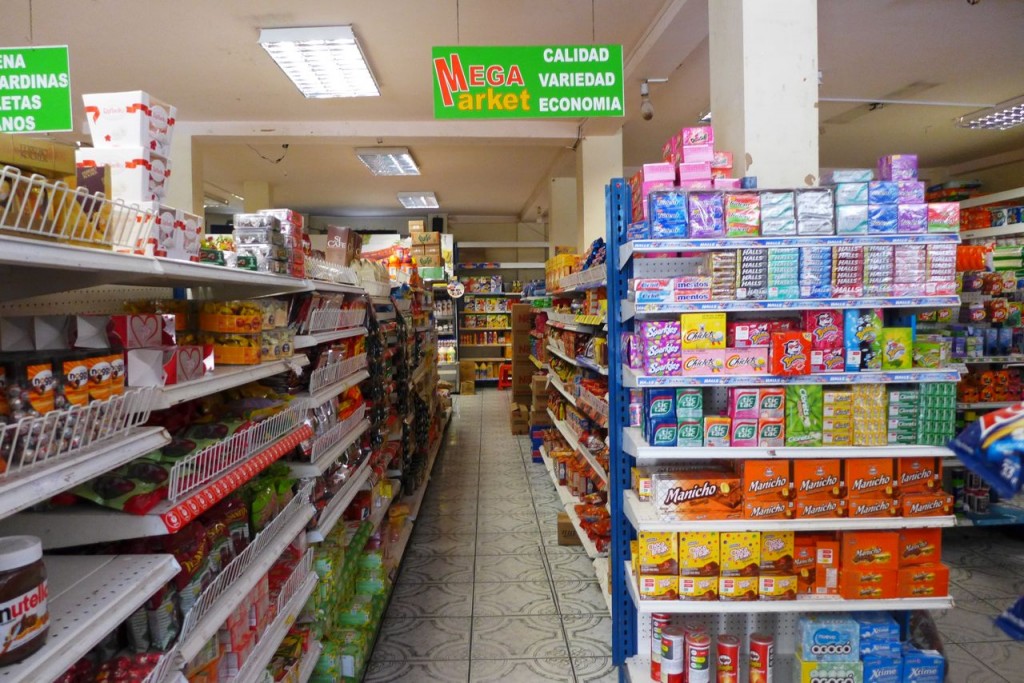
A collateral effect of migration – leaving children behind with elderly grandparents, and sending money regularly – has meant a degradation of the traditional Andean diet (potatoes, beans, barley, peas, favas, guinea pig) and the introduction of junk food, called chatara, meaning literally “junk.” Grandparents buy quick-cooking foods for growing children: noodles, ramen, rice, hotdogs. And kids buy all sorts of sugary drinks and sweets, with the result that nearly every child under five years has black stubs for teeth.
• • • • • •
And we still have this – every Sunday!
For Michael and me, shopping is personal, a pleasure, and a chance for a social transaction we would not otherwise have. During the construction of the house, the folks at Michael’s hardware store became trusted friends (with credit and discount): Gladys, Maria Elena, Klever. We invited them to the housewarming celebration. For years I’ve bought roses from the medicinal plant woman in the Feria Libre, and although I don’t know her name, and she doesn’t know mine, she notices when I’ve been gone, and I ask after her family. Seeing her sweet face is one reward of my weekly routine.
For years I’ve bought roses from the medicinal plant woman in the Feria Libre, and although I don’t know her name, and she doesn’t know mine, she notices when I’ve been gone, and I ask after her family. Seeing her sweet face is one reward of my weekly routine. As I finish writing this, it is another Sunday morning, this one gray and rainy. Michael is just leaving for the market, to check in on César and see what he has for fresh fish today. “Mira Miquito – pescados frescos!”
As I finish writing this, it is another Sunday morning, this one gray and rainy. Michael is just leaving for the market, to check in on César and see what he has for fresh fish today. “Mira Miquito – pescados frescos!”

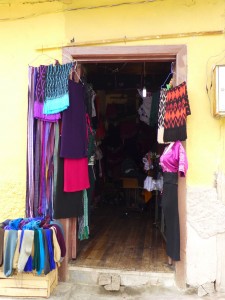
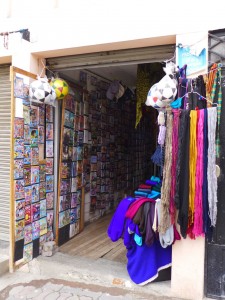
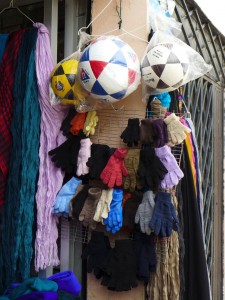

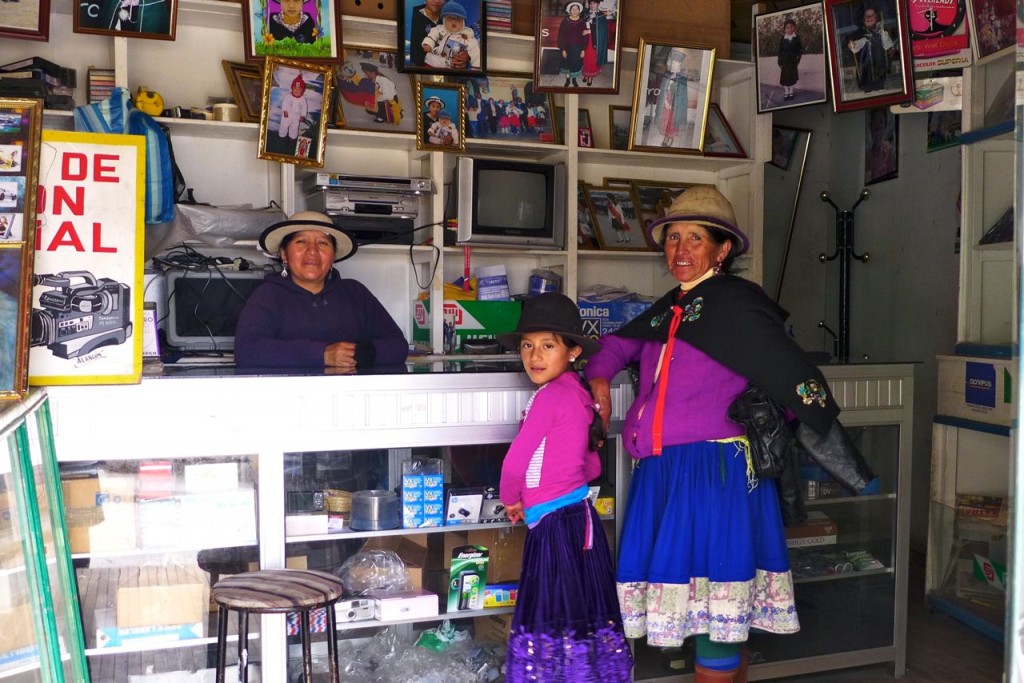


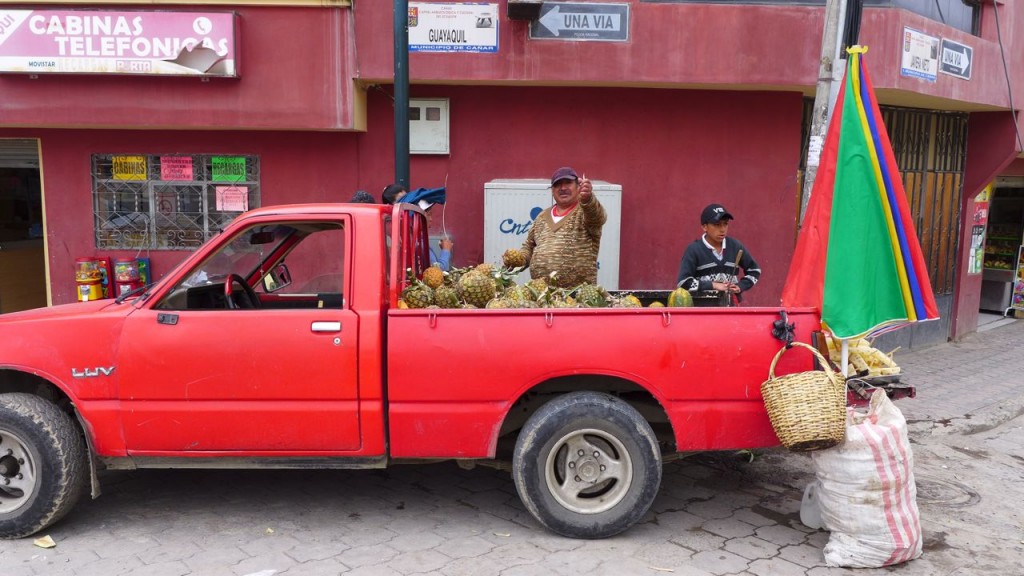


I always loved the market, and would wait to buy my groceries on the weekends when visiting my in-laws in Ibarra, which has a wonderful open air market rivaling anything in Quito. Saludos!
I am an old friend of Patty Torchia, and a member of our long time
book group that you spoke at a few years back. Patty forwards me
your posts, and I throughly enjoy reading them. The photos are
wonderful and really give descriptive visual of your surroundings.
I am looking forward to more.
Such fun to see all this! I notice that in the 45-yr-old photo, the traditional dress seems much more prevalent. (Love those fabulous chaps!) Great photo of you, usually so elusive. What is Miquito cooking for you these days? xo
Re that 45 year-old photo taken by a Peace Corps volunteer, look closely at the faces. .Then look at the faces in the modern pictures. Much has changed!
Excellent photos! Those chirimoya look ripe. How long is their season?
I’ve been mentally preparing myself to say “no” repeatedly to my children when they ask for “chatara” – not that it is any different from their lives here where junkfood is even more plentiful. Thanks for the great post.